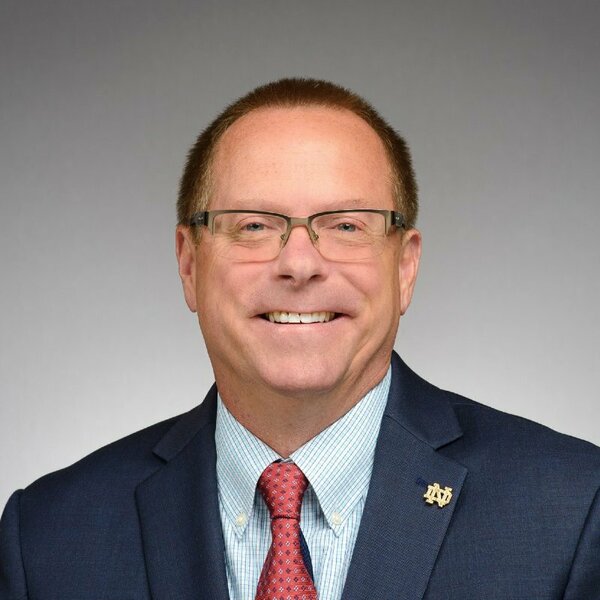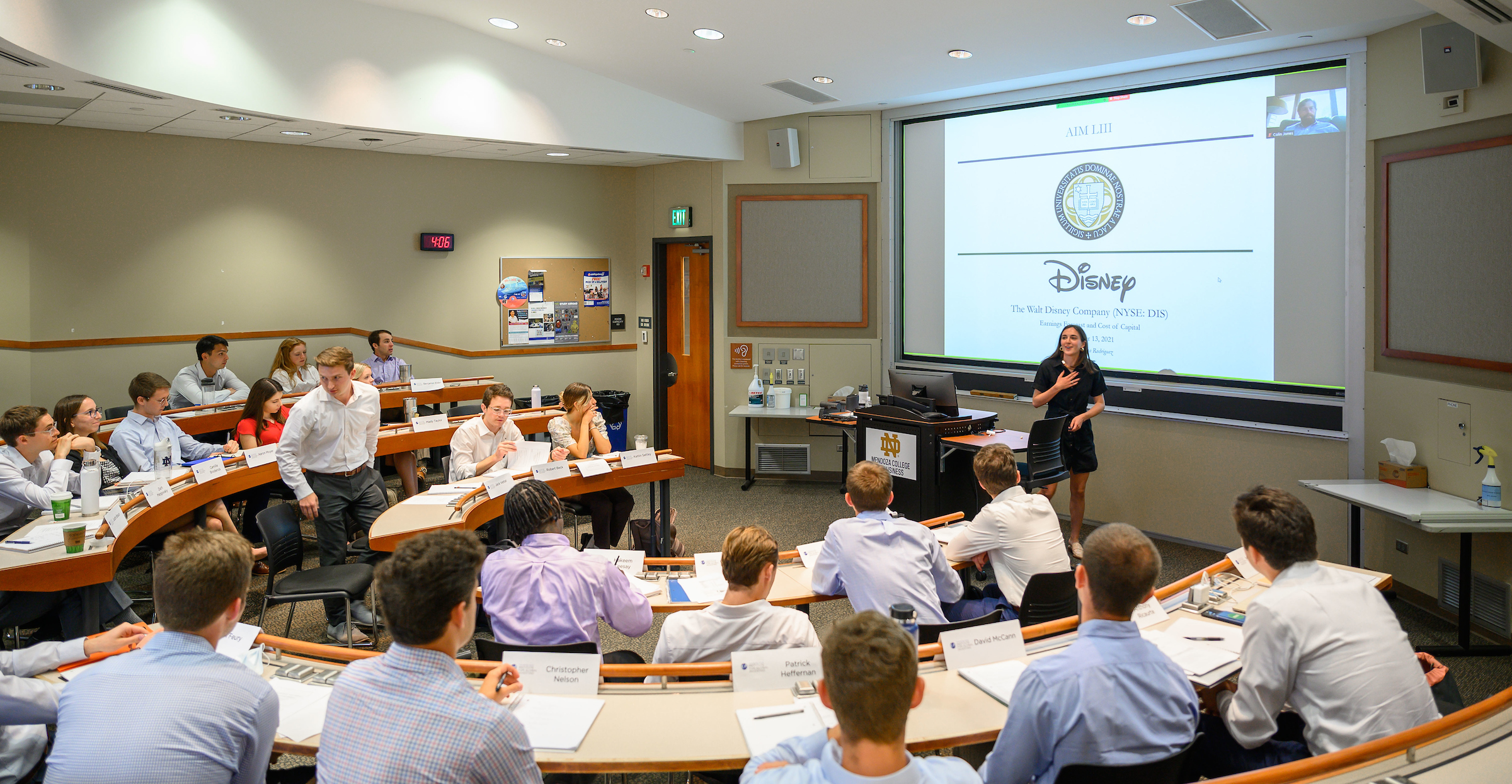“It’s the old adage, ‘If you want to go fast, go alone. If you want to go far, go together.’” —Tom Marentette, IT solutions architect and streaming program manager at the University of Notre Dame

Steeped in tradition but always striving to innovate, Notre Dame was an early adopter of the Zoom platform several years ago. That became key when the COVID-19 pandemic hit in March of 2020, and it had to pivot to full-scale, remote use for faculty, students and business operations.
In addition, its Mendoza College of Business also had done some experimenting with an enterprise-level video management system called Panopto. One of its key features is the ability to record and save classroom lectures for future use by students. Those two worlds—the live video connection and the asynchronous component—largely lived independently, but Marentette and his team saw an opportunity to blend both to create a “classroom as an ecosystem.”
Over the course of the past two years and on the strength of institutional backing, Notre Dame created and scaled up dual-mode classrooms of the future, providing faculty with an array of tools to keep students engaged with flexible learning options.
While Notre Dame’s intention, like so many other institutions across higher education, is to maintain in-person instruction, the initiative’s build-out and success cannot be ignored. The embrace of technology by campus stakeholders, especially those who teach and those who learn, means the exploration and lean into technology use in the future will continue.
“Tradition is nice, but it can also slow us down,” Marentette says. “You have to look forward, as well. At Notre Dame, we have a strong culture of community. That face-to-face experience and relationship building is so important. With this new approach, how do we try to keep that community? We’ve got a lot of bright faculty, and now the light bulbs are going off: ‘I understand how to use this technology in the classroom, can I use that for other purposes like bringing in guest speakers, doing different types of tutoring sessions?’ That’s exciting. That’s why we’re all here.”

Scaling up in a supportive environment
Before the notion of the ecosystem began, Notre Dame admittedly was in “building the plane as you fly it” mode trying to get class meetups off the ground at the start of the pandemic. One of its first missions was strengthening Zoom capacity and continuity across campus and layering in all the cameras, microphones and other technologies, building on an overall campus strategy of keeping all audio and visual components consistent. That was a challenge given that 150-160 classrooms would get a tech makeover, including spaces that were completely different.
“We’re fortunate to have very solid core standards for our AV equipment,” Marentette said. “But the ability to layer on top of that a mix of different camera technologies, some audio processors, some ceiling array microphones—depending upon the size and the shape of the room—there might be one to three microphones. There might be a tie-in to the local audio system if it’s a large lecture hall. So, the customization, as much as we try to keep things standard, is much different from a 15-person seminar room to a 500-seat lecture hall.”
More from UB: 5 tech leaders say higher ed must do more to meet employer demands
Despite the complexities, Notre Dame realized the value of integrating Panopto in redesigning and redefining its classes. Integrating it with Zoom could be beneficial for course delivery and capture. Recordings could be delivered asynchronously on learning management systems for students, too, and even outside of them for administrators. That sounded great, but there were three major concerns for all of it—supply chain shortages, an embrace by campus leaders and getting students and faculty on board.
A favorable go-ahead from administrators meant Notre Dame would avoid the equipment problems that plagued so many schools and institutions in the spring and summer of 2020. The second part has been a work in progress, with IT providing a “safety net” of services for instructors and students.
“Our university leadership, all the way up to our executive VP level was absolutely 100% supportive in what we needed to do,” Marentette says. “While we were moving fast, we needed to make sure that our faculty and students wouldn’t come in and be completely lost. In addition to the technical components, there was a human side: What kind of workshops do we need for faculty? How do we get training in front of people so they can participate in this new environment?”
The shift to dual mode has been well-received by the campus community, Marentette said, including faculty members who continue now to push for more tech opportunities, including time away from the class. “Our faculty are thinking more creatively about how they’re using media,” he says. “So it’s going from that 90-minute lecture, which was great for that triage moment, to doing 2-5-minute explainer videos, working through problem sets and recording them. We’ve also heard from faculty that they’ve reduced their need for [in-person] office hours.”

The future of dual mode at Notre Dame
In its embrace of the technology, Notre Dame’s IT team also leveraged a few innovative tools, including Zoom Appointment Provisioner. “We’ve created a Zoom link for every course that’s offered at Notre Dame each semester (around 7,300) to save our faculty the time and the angst of creating their own meetings,” he says. “This was a big win for us.”
Another big plus of asynchronous is that it offers equity for all students who may be unable to attend classes, including “the ability to be able to go back and review the lecture. Maybe your notes weren’t that great, or you were traveling as a student-athlete. Maybe you were out at a job interview,” Marentette said.
Aside from the opportunities for students and faculty, campuses that embrace this type of ecosystem across a large range of classrooms also gain the capacity to hold events or lecture series and capture them wherever and whenever they want. “I’ve been a guest speaker in the classrooms in the past, but it’s always been, we have to use this room, or we have to use this space,” Marentette says. “Now, we have roughly 150 or so to choose from to bring guest speakers in. That really opens up the experts we can bring to the Notre Dame classroom, and that’s just powerful.”
The willingness to implement the new ecosystem was not inexpensive. But Marentette says Notre Dame is intent on continually looking for ways to improve the class experience for students. “The most important thing is being there for them to continue the educational mission of Notre Dame,” he says. “Nothing’s too good for our students and faculty. As we designed this, we were cost-conscious and trying to keep an eye on the budget. But when it came down to it, it was very important for us to provide as much of that experience for our students as possible in an equitable way. A challenge going forward is there are probably another 150 classrooms that are departmental spaces controlled by different units on campus. As we look towards enterprise audio/visual on campus and those new standards that we have, there are going to be cost factors involved.”

